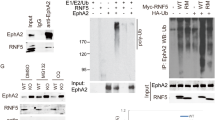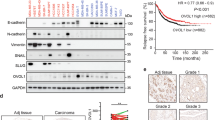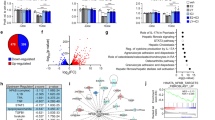Abstract
Hypoxia and inflammatory cytokines like interleukin-6 (IL-6, IL6) are strongly linked to cancer progression, and signal in part through the transcription factor Ccaat/enhancer-binding protein δ (C/EBPδ, CEBPD), which has been shown to promote mesenchymal features and malignant progression of glioblastoma. Here we report a different role for C/EBPδ in breast cancer. We found that the C/EBPδ protein is expressed in normal breast epithelial cells and in low-grade cancers. C/EBPδ protein (but not mRNA) expression correlates with estrogen receptor (ER+) and progesterone receptor (PGR) expression and longer progression-free survival of breast cancer patients. Specifically in ER+ breast cancers, CEBPD—but not the related CEBPB—mRNA in combination with IL6 correlated with lower risk of progression. Functional studies in cell lines showed that ERα promotes C/EBPδ expression at the level of protein stability by inhibition of the FBXW7 pathway. Furthermore, we found that C/EBPδ attenuates cell growth, motility and invasiveness by inhibiting expression of the SNAI2 (Slug) transcriptional repressor, which leads to expression of the cyclin-dependent kinase inhibitor CDKN1A (p21CIP1/WAF1). These findings identify a molecular mechanism by which ERα signaling reduces the aggressiveness of cancer cells, and demonstrate that C/EBPδ can have different functions in different types of cancer. Furthermore, our results support a potentially beneficial role for the IL-6 pathway specifically in ER+ breast cancer and call for further evaluation of the role of intra-tumoral IL-6 expression and of which cancers might benefit from current attempts to target the IL-6 pathway as a therapeutic strategy.
This is a preview of subscription content, access via your institution
Access options
Subscribe to this journal
Receive 50 print issues and online access
$259.00 per year
only $5.18 per issue
Buy this article
- Purchase on Springer Link
- Instant access to full article PDF
Prices may be subject to local taxes which are calculated during checkout





Similar content being viewed by others
References
Taniguchi K, Karin M . IL-6 and related cytokines as the critical lynchpins between inflammation and cancer. Semin Immunol 2014; 26: 54–74.
Martinson HA, Jindal S, Durand-Rougely C, Borges VF, Schedin P . Wound healing-like immune program facilitates postpartum mammary gland involution and tumor progression. Int J Cancer 2015; 136: 1803–1813.
Resemann HK, Watson CJ, Lloyd-Lewis B . The Stat3 paradox: a killer and an oncogene. Mol Cell Endocrinol 2014; 382: 603–611.
Balamurugan K, Sterneck E . The Many Faces of C/EBPdelta and their Implications in Inflammation and Cancer. Int J Biol Sci 2013; 9: 917–933.
Ramji DP, Foka P . CCAAT/enhancer-binding proteins: structure, function and regulation. Biochem J 2002; 365: 561–575.
Thangaraju M, Rudelius M, Bierie B, Raffeld M, Sharan S, Hennighausen L et al. C/EBPdelta is a crucial regulator of pro-apoptotic gene expression during mammary gland involution. Development 2005; 132: 4675–4685.
Balamurugan K, Wang JM, Tsai HH, Sharan S, Anver M, Leighty R et al. The tumour suppressor C/EBPdelta inhibits FBXW7 expression and promotes mammary tumour metastasis. Embo J 2010; 29: 4106–4117.
Balamurugan K, Sharan S, Klarmann KD, Zhang Y, Coppola V, Summers GH et al. FBXW7alpha attenuates inflammatory signalling by downregulating C/EBPdelta and its target gene Tlr4. Nature communications 2013; 4: 1662.
Hagedorn M, Delugin M, Abraldes I, Allain N, Belaud-Rotureau MA, Turmo M et al. FBXW7/hCDC4 controls glioma cell proliferation in vitro and is a prognostic marker for survival in glioblastoma patients. Cell Div 2007; 2: 9.
Chen JC, Alvarez MJ, Talos F, Dhruv H, Rieckhof GE, Iyer A et al. Identification of causal genetic drivers of human disease through systems-level analysis of regulatory networks. Cell 2014; 159: 402–414.
Liu J, Li J, Li H, Li A, Liu B, Han L . A comprehensive analysis of candidate genes and pathways in pancreatic cancer. Tumour Biol 2015; 36: 1849–1857.
Wang YH, Wu WJ, Wang WJ, Huang HY, Li WM, Yeh BW et al. CEBPD amplification and overexpression in urothelial carcinoma: a driver of tumor metastasis indicating adverse prognosis. Oncotarget 2015; 6: 31069–31084.
Ranger JJ, Levy DE, Shahalizadeh S, Hallett M, Muller WJ . Identification of a Stat3-dependent transcription regulatory network involved in metastatic progression. Cancer Res 2009; 69: 6823–6830.
Naderi A, Teschendorff AE, Barbosa-Morais NL, Pinder SE, Green AR, Powe DG et al. A gene-expression signature to predict survival in breast cancer across independent data sets. Oncogene 2007; 26: 1507–1516.
Porter DA, Krop IE, Nasser S, Sgroi D, Kaelin CM, Marks JR et al. A sage (serial analysis of gene expression) view of breast tumor progression. Cancer Res 2001; 61: 5697–5702.
Pawar SA, Sarkar TR, Balamurugan K, Sharan S, Wang J, Zhang Y et al. C/EBP{delta} targets cyclin D1 for proteasome-mediated degradation via induction of CDC27/APC3 expression. Proc Natl Acad Sci USA 2010; 107: 9210–9215.
Milde-Langosch K, Loning T, Bamberger AM . Expression of the CCAAT/enhancer-binding proteins C/EBPalpha, C/EBPbeta and C/EBPdelta in breast cancer: correlations with clinicopathologic parameters and cell-cycle regulatory proteins. Breast Cancer Res Treat 2003; 79: 175–185.
Ikezoe T, Gery S, Yin D, O'Kelly J, Binderup L, Lemp N et al. CCAAT/enhancer-binding protein delta: a molecular target of 1,25-dihydroxyvitamin D3 in androgen-responsive prostate cancer LNCaP cells. Cancer Res 2005; 65: 4762–4768.
Sarkar TR, Sharan S, Wang J, Pawar SA, Cantwell CA, Johnson PF et al. Identification of a Src tyrosine kinase/SIAH2 E3 ubiquitin ligase pathway that regulates C/EBPdelta expression and contributes to transformation of breast tumor cells. Mol Cell Biol 2012; 32: 320–332.
Cicenas J, Valius M . The CDK inhibitors in cancer research and therapy. J Cancer Res Clin Oncol 2011; 137: 1409–1418.
Chaudary N, Hill RP . Hypoxia and metastasis in breast cancer. Breast Dis 2006; 26: 55–64.
Davis RJ, Welcker M, Clurman BE . Tumor suppression by the Fbw7 ubiquitin ligase: mechanisms and opportunities. Cancer Cell 2014; 26: 455–464.
Zhang F, Phiel CJ, Spece L, Gurvich N, Klein PS . Inhibitory phosphorylation of glycogen synthase kinase-3 (GSK-3) in response to lithium. Evidence for autoregulation of GSK-3. J Biol Chem 2003; 278: 33067–33077.
Baranda-Avila N, Mendoza-Rodriguez CA, Morimoto S, Camacho-Arroyo I, Guerra-Araiza C, Langley E et al. Agonistic activity of ICI 182 780 on activation of GSK 3beta/AKT pathway in the rat uterus during the estrous cycle. Steroids 2013; 78: 717–725.
Cardona-Gomez P, Perez M, Avila J, Garcia-Segura LM, Wandosell F . Estradiol inhibits GSK3 and regulates interaction of estrogen receptors, GSK3, and beta-catenin in the hippocampus. Mol Cell Neurosci 2004; 25: 363–373.
Ye Y, Xiao Y, Wang W, Yearsley K, Gao JX, Shetuni B et al. ERalpha signaling through slug regulates E-cadherin and EMT. Oncogene 2010; 29: 1451–1462.
Wang Z, Inuzuka H, Zhong J, Wan L, Fukushima H, Sarkar FH et al. Tumor suppressor functions of FBW7 in cancer development and progression. FEBS Lett 2012; 586: 1409–1418.
Stamos JL, Weis WI . The beta-catenin destruction complex. Cold Spring Harb Perspect Biol 2013; 5: a007898.
Eroles P, Bosch A, Perez-Fidalgo JA, Lluch A . Molecular biology in breast cancer: intrinsic subtypes and signaling pathways. Cancer Treat Rev 2012; 38: 698–707.
Yu X, Si J, Zhang Y, Dewille JW . CCAAT/Enhancer Binding Protein-delta (C/EBP-delta) regulates cell growth, migration and differentiation. Cancer Cell Int 2010; 10: 48.
Sanchez-Garcia F, Villagrasa P, Matsui J, Kotliar D, Castro V, Akavia UD et al. Integration of genomic data enables selective discovery of breast cancer drivers. Cell 2014; 159: 1461–1475.
van Roosmalen W, Le Devedec SE, Golani O, Smid M, Pulyakhina I, Timmermans AM et al. Tumor cell migration screen identifies SRPK1 as breast cancer metastasis determinant. J Clin Invest 2015; 125: 1648–1664.
Cobaleda C, Perez-Caro M, Vicente-Duenas C, Sanchez-Garcia I . Function of the zinc-finger transcription factor SNAI2 in cancer and development. Annu Rev Genet 2007; 41: 41–61.
Dhasarathy A, Phadke D, Mav D, Shah RR, Wade PA . The transcription factors Snail and Slug activate the transforming growth factor-beta signaling pathway in breast cancer. PLoS One 2011; 6: e26514.
Liao XH, Lu DL, Wang N, Liu LY, Wang Y, Li YQ et al. Estrogen receptor alpha mediates proliferation of breast cancer MCF-7 cells via a p21/PCNA/E2F1-dependent pathway. FEBS J 2014; 281: 927–942.
Bermejo-Rodriguez C, Perez-Caro M, Perez-Mancera PA, Sanchez-Beato M, Piris MA, Sanchez-Garcia I . Mouse cDNA microarray analysis uncovers Slug targets in mouse embryonic fibroblasts. Genomics 2006; 87: 113–118.
Dethlefsen C, Hojfeldt G, Hojman P . The role of intratumoral and systemic IL-6 in breast cancer. Breast Cancer Res Treat 2013; 138: 657–664.
Madden SF, Clarke C, Gaule P, Aherne ST, O'Donovan N, Clynes M et al. BreastMark: an integrated approach to mining publicly available transcriptomic datasets relating to breast cancer outcome. Breast Cancer Res 2013; 15: R52.
Grisouard J, Medunjanin S, Hermani A, Shukla A, Mayer D . Glycogen synthase kinase-3 protects estrogen receptor alpha from proteasomal degradation and is required for full transcriptional activity of the receptor. Mol Endocrinol 2007; 21: 2427–2439.
Wei G, Wang Y, Zhang P, Lu J, Mao JH . Evaluating the prognostic significance of FBXW7 expression level in human breast cancer by a meta-analysis of transcriptional profiles. J Cancer Sci Ther 2012; 4: 299–305.
Carroll JS, Meyer CA, Song J, Li W, Geistlinger TR, Eeckhoute J et al. Genome-wide analysis of estrogen receptor binding sites. Nat Genet 2006; 38: 1289–1297.
Hefti MM, Hu R, Knoblauch NW, Collins LC, Haibe-Kains B, Tamimi RM et al. Estrogen receptor negative/progesterone receptor positive breast cancer is not a reproducible subtype. Breast Cancer Res 2013; 15: R68.
Bailey CK, Mittal MK, Misra S, Chaudhuri G . High motility of triple-negative breast cancer cells is due to repression of plakoglobin gene by metastasis modulator protein SLUG. J Biol Chem 2012; 287: 19472–19486.
Phillips S, Prat A, Sedic M, Proia T, Wronski A, Mazumdar S et al. Cell-state transitions regulated by SLUG are critical for tissue regeneration and tumor initiation. Stem Cell Rep 2014; 2: 633–647.
Alves CC, Carneiro F, Hoefler H, Becker KF . Role of the epithelial-mesenchymal transition regulator Slug in primary human cancers. Front Biosci (Landmark Ed) 2009; 14: 3035–3050.
Guo W, Keckesova Z, Donaher JL, Shibue T, Tischler V, Reinhardt F et al. Slug and Sox9 cooperatively determine the mammary stem cell state. Cell 2012; 148: 1015–1028.
Reed W, Florems VA, Holm R, Hannisdal E, Nesland JM . Elevated levels of p27, p21 and cyclin D1 correlate with positive oestrogen and progesterone receptor status in node-negative breast carcinoma patients. Virchows Arch 1999; 435: 116–124.
Lyng MB, Laenkholm AV, Tan Q, Vach W, Gravgaard KH, Knoop A et al. Gene expression signatures that predict outcome of tamoxifen-treated estrogen receptor-positive, high-risk, primary breast cancer patients: a DBCG study. PLoS One 2013; 8: e54078.
Korkaya H, Liu S, Wicha MS . Breast cancer stem cells, cytokine networks, and the tumor microenvironment. J Clin Invest 2011; 121: 3804–3809.
Knupfer H, Preiss R . Significance of interleukin-6 (IL-6) in breast cancer (review). Breast Cancer Res Treat 2007; 102: 129–135.
Sanford DC, DeWille JW . C/EBPdelta is a downstream mediator of IL-6 induced growth inhibition of prostate cancer cells. Prostate 2005; 63: 143–154.
Hutt JA, DeWille JW . Oncostatin M induces growth arrest of mammary epithelium via a CCAAT/enhancer-binding protein delta-dependent pathway. Mol Cancer Ther 2002; 1: 601–610.
Begay V, Smink JJ, Loddenkemper C, Zimmermann K, Rudolph C, Scheller M et al. Deregulation of the endogenous C/EBPbeta LIP isoform predisposes to tumorigenesis. J Mol Med (Berl) 2015; 93: 39–49.
Zahnow CA . CCAAT/enhancer-binding protein beta: its role in breast cancer and associations with receptor tyrosine kinases. Expert Rev Mol Med 2009; 11: e12.
Jones SA, Scheller J, Rose-John S . Therapeutic strategies for the clinical blockade of IL-6/gp130 signaling. J Clin Invest 2011; 121: 3375–3383.
Chin SF, Teschendorff AE, Marioni JC, Wang Y, Barbosa-Morais NL, Thorne NP et al. High-resolution aCGH and expression profiling identifies a novel genomic subtype of ER negative breast cancer. Genome Biol 2007; 8: R215.
Ryden L, Jonsson PE, Chebil G, Dufmats M, Ferno M, Jirstrom K et al. Two years of adjuvant tamoxifen in premenopausal patients with breast cancer: a randomised, controlled trial with long-term follow-up. Eur J Cancer 2005; 41: 256–264.
Ringner M, Fredlund E, Hakkinen J, Borg A, Staaf J . GOBO: gene expression-based outcome for breast cancer online. PLoS One 2011; 6: e17911.
Acknowledgements
We are thankful to the Laboratory Animal Sciences Program (Leidos Biomedical Research, Inc., Frederick National Laboratory for Cancer Research) for excellent support, especially Donna Butcher and Glenn Summers for superb services, and Bao Tran and Jyoti Shetty (Leidos Biomedical Research, Inc.) for mRNA-Seq data. We also thank Elise Nilsson for excellent technical assistance. We thank student interns Katherine L Zhou and Yasmin Y Lachir for their valuable contributions, Linda Miller for preparation of plasmids, and Allen Kane and Joseph Meyer (Leidos Biomedical Research, Inc.) for preparing the figures for publication. This research was supported by the Intramural Research Program of the NIH, National Cancer Institute and in part with Federal Funds from the Frederick National Laboratory (NIH) under contract no. HHSN261200800001E. DM-V was supported in part by a scholarship from the National Council on Science and Technology (CONACYT), Mexico. The content of this publication does not necessarily reflect the views or policies of the Department of Health and Human Services, nor does mention of trade names, commercial products or organizations imply endorsement by the US Government.
Author information
Authors and Affiliations
Corresponding author
Ethics declarations
Competing interests
The authors declare no conflict of interest.
Additional information
Supplementary Information accompanies this paper on the Oncogene website
Supplementary information
Rights and permissions
About this article
Cite this article
Mendoza-Villanueva, D., Balamurugan, K., Ali, H. et al. The C/EBPδ protein is stabilized by estrogen receptor α activity, inhibits SNAI2 expression and associates with good prognosis in breast cancer. Oncogene 35, 6166–6176 (2016). https://doi.org/10.1038/onc.2016.156
Received:
Revised:
Accepted:
Published:
Issue Date:
DOI: https://doi.org/10.1038/onc.2016.156
This article is cited by
-
FBXW7 in breast cancer: mechanism of action and therapeutic potential
Journal of Experimental & Clinical Cancer Research (2023)
-
Tumor suppressor DEAR1 regulates mammary epithelial cell fate and predicts early onset and metastasis in triple negative breast cancer
Scientific Reports (2022)
-
An Integrative Single-cell Transcriptomic Atlas of the Post-natal Mouse Mammary Gland Allows Discovery of New Developmental Trajectories in the Luminal Compartment
Journal of Mammary Gland Biology and Neoplasia (2021)
-
C/EBPδ links IL-6 and HIF-1 signaling to promote breast cancer stem cell-associated phenotypes
Oncogene (2019)



